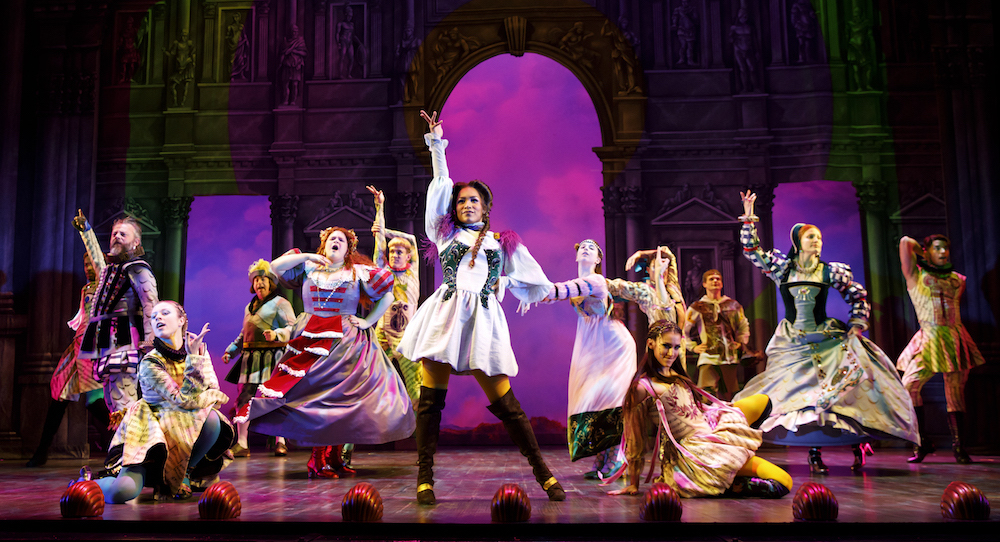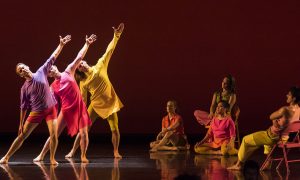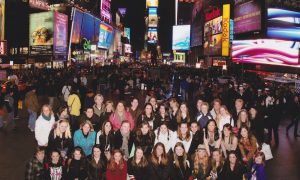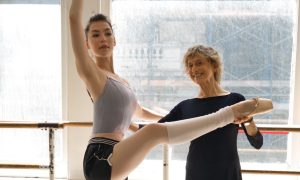Along with a glowing performing resume of his own, Spencer Liff’s choreography resume is lighting up, too. He worked as a choreographer on five seasons of the FOX hit series, So You Think You Can Dance (SYTYCD), Broadway’s Hedwig and the Angry Inch, the 2013 Emmy Awards starring Neil Patrick Harris, and many more television and live theater projects across the country. His current job: choreographing the highly-anticipated new Broadway musical, Head Over Heels. Now, how does a 16th-century prose romance pair with the 1980s punk rock music of The Go-Go’s to tell a poignant story for modern audiences? To be honest, we hadn’t a clue! So, Dance Informa chatted with Liff (during his day off from tech rehearsals at the Hudson Theatre) about his quirky, cool new musical to hit the Great White Way.
How did you become a dancer and eventually turn to choreography?
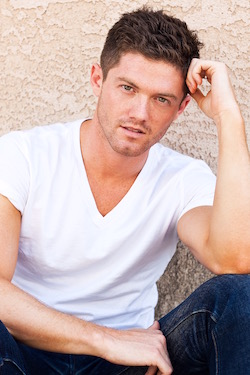
Spencer Liff. Photo courtesy of LSG Public Relations.
“I started dancing professionally when I was very, very young. My parents loved Broadway and started taking me to shows when I was just four years old. I auditioned for — and booked — my first professional job in the national tour of Tommy Tune’s The Will Rogers Follies when I was six. I toured the country for about a year before I got my first Broadway show, Susan Stroman’s Big The Musical, when I was nine. So, from a very early age, I got the opportunity to work with some incredible directors and choreographers.
I never thought there was anything else in the world that I’d be happier doing than performing on stage. My path was a little atypical. I didn’t grow up dancing at a studio or with a competition team, but I trained at places like Tremaine, The EDGE, Broadway Dance Center, Steps on Broadway and The School of American Ballet. I was lucky to have had a lot of male teachers, which, I think, helped me cultivate a strong masculine quality in my dancing. But, although I dabbled in contemporary and ballet in my training, my heart was always in Broadway.
In my first Broadway show as an adult, The Wedding Singer, I met a choreographer named Rob Ashford, for whom I later became an assistant and then associate choreographer for several years. From working with Rob — and going on to assist many other choreographers like Kathleen Marshall, Warren Carlyle, and Sergio Trujillo — I learned that I was capable of and excited to choreograph myself.
And then I got the opportunity to choreograph for So You Think You Can Dance when I was 23. Yes, the first thing that I had ever choreographed on my own, on other people and in a professional setting was on that show! It was kind of insane and such a big leap into finding my own voice. Everything I learned about choreography and who I am as a choreographer I learned on SYTYCD — in front of America! There wasn’t a lot of ‘private’ time to make mistakes and stumble and fall. You were thrown into the trenches and couldn’t second guess yourself.
I don’t think I’ll ever experience the same amount of intense pressure as I did working on that show. It was thrilling, of course, but with such a fast, jam-packed schedule, you had to just roll with the punches. Week after week, you have to come up with new concepts and new ideas, raising the bar every time your work is on stage. Maybe you have a very specific technical piece in mind, but the dancers you pull out of the hat are B-boys. I didn’t know who my dancers would be until the night before our first rehearsal. And I only got about six hours in the studio with the dancers before they performed live on stage. Logistical complications would happen, too. I would have a piece choreographed, but then producers would inform me that we couldn’t get the music rights cleared, so I’d have to start over. Or sometimes we’d have a rehearsal, and then I’d be told that the set pieces can’t fit on the stage as originally planned and we’d have to reimagine the context of the number. But even aside from all of the crazy situations that can (and often do) come up, it’s not often that a choreographer is asked to fully conceive and direct every aspect of a work — from the movement and costumes to the camera angles and music edits. The SYTYCD choreographers are really the choreographers, directors, producers and stage managers all rolled up in one. You’ll never get that kind of creative freedom (and responsibility) anywhere else as a choreographer as you do on that show.”
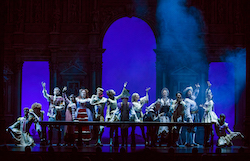
The ‘Head Over Heels’ company. Photo by Joan Marcus.
So how does your experience on SYTYCD translate to choreographing for Broadway?
“They’re two very different animals. On Broadway, you (the choreographer) work as part of a much larger creative and design team. The production is often about more than just the dancing — the music, the book. Also, on TV, I can direct the camera to focus on a specific moment or movement. But in choreographing for the theater, you have to make sure that every inch of the stage is perfect because you don’t know where each audience member might look. Your job is to try and focus their eye, but you have to think about the bigger picture.”
What is your approach to choreographing a brand-new project? What is your creative process like?
“Every choreographer has their own process. I actually don’t do a ton of pre-production. I’ve found that what I do in pre-production often doesn’t end up in the show because until I get my actual dancers in the room, I don’t have a full sense of the energy and inspiration of the company. I work with my assistant for about two days of pre-pro, but once rehearsals start, she and I meet every morning to work on the number that’s in front of us for that day. This not only keeps us focused each day, but it also breaks down the big, overwhelming project into manageable parts.
My inspiration definitely starts with images in my head. I’ll usually just seek one shot or image or moment in a song, and then that will be the key to unlock a number. Now for this show, Head Over Heels, I only got a few pages into the script before I fell in love with it. I could picture exactly who these people were — how they dressed, how they spoke, how they moved. And it was very clear to me that I had to do this project because I was so immediately clicked-in to the work.
And this wasn’t initially a ‘dance show’ when I first read it. But I knew that the movement could provide such an interesting piece to the puzzle and such a contemporary cool factor. Our script is based on a book that was written in the 1500s — written in Elizabethan verse (iambic pentameter) — and set to 1980s punk rock music of The Go-Go’s. This is such a crazy juxtaposition, and I didn’t want the dance to live in either of those worlds; it had to be its own element, the most contemporary piece of it all. I started with just eight counts of eight in the opening number, and that bit of choreography really inspired the vocabulary of the whole production.”
What is the movement vocabulary of Head Over Heels?
“I grew up in New York City in the ’90s, and used to frequent the club scene. I was fascinated with these club personalities and club kids at places like the Tunnel and the Limelight. I had never seen stuff like that on Broadway. The freedom and expression of movement was all sort of inspired from Voguing and this underground queer club world. I like to think of each number as its own MTV music video. The show also oddly reminds me of the musical Pippin, choreographed by Bob Fosse. So, if there’s any sort of homage, I liked to imagine…how would have Fosse choreographed Pippin today?
I really killed myself casting this show. I saw over 600 dancers (for an ensemble cast of eight). I needed dancers who brought a totally different style to the table than what most of the dancers in New York City have been trained in, almost closer to ‘LA dancers’ or ‘tour dancers’ than traditional musical theater dancers. For about half of my dancers, this will be their Broadway debut. I wanted to bring fresh faces and a new energy to the Broadway stage.”
How is Head Over Heels different from other jukebox musicals that we’ve seen on Broadway recently?
“For one, most people will assume that the show is about The Go-Go’s, which it is not. I will never understand how our book writer, Jeff Whitty, thought to put this ’80s music with this Elizabethan story, but the second the first number starts, you’re immediately engaged and invested in the show. The topics of Head Over Heels are so incredibly of the moment — female empowerment, queer love, living true to yourself — and it’s pretty incredible to see that those themes were in the original text written back in the 16th century.
Head Over Heels is just such a crazy mash-up of worlds that shouldn’t work, but they do, and magically so. We got to create our own fantasy land where the characters sound, dance, dress and act like however we choose, and that was really unusual and exciting for our whole creative team.”
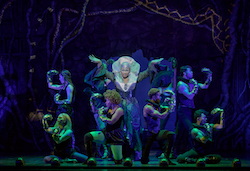
Peppermint (center) as Pythio, The Oracle of Delphi, and the ensemble in ‘Head Over Heel’s. Photo by Joan Marcus.
Did you grow up listening to The Go-Go’s? What do you think is so powerful or special about their music?
“I did because my mom loved them! The Go-Go’s had several top hits, but there are 18 numbers in our show, and audiences will discover Go-Go’s songs that they didn’t know before. I am excited for this younger generation to experience The Go-Go’s nearly 20-year legacy of music.
And the girls of The Go-Go’s band have been around during this whole process. They are so excited to share their music with Broadway audiences.”
What do you hope audiences take away from seeing Head Over Heels?
“It’s kind of a beautiful utopian idea of a world and the lessons that our characters learn. They all walk out better in the end by accepting who someone else is and by being honest about who they are themselves. We’re able to explore these themes without calling upon any real topical political stuff, so audiences can escape. I want people to dive into this show, live with us in this world for two hours and never want to leave. I hope that people from all over the country and the world come to see Head Over Heels knowing they’re seeing a really joyful, innovative and cutting-edge piece of theater.”
Head Over Heels opens at the Hudson Theatre on July 26. For more information and to purchase tickets, visit www.headoverheelsthemusical.com.
By Mary Callahan of Dance Informa.


